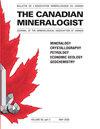第一个具有反烧绿石结构的天然铌酸铯
IF 1.5
4区 地球科学
Q3 MINERALOGY
引用次数: 4
摘要
烧绿石是一种新的烧绿石矿物。它是在马达加斯加Betafo地区Tetezantsio采集的花岗伟晶岩样本中发现的。该矿物与贝氏岩和龙须岩共生,形成大小达0.05毫米的粗糙等晶。三氯二苯醚呈浅棕色,半透明,有树脂光泽。Dcalc.=5.984g/cm3。在反射光中,它是浅灰色的,各向同性的,具有强烈的浅棕色内部反射。晶体结构被细化为R1=0.0212。该矿物为立方体,a=10.444(1)Å,V=1139.5(2)Å3,Z=8。粉末X射线衍射图的最强谱线[d,Å,(I,%)(hkl)]为:6.03(37)(111)、3.70(9)(220)、3.15(100)(311)、3.02(36)(222)、2.012(17)(511333)、1.848(19)(440)、1.576(11)(622)。化学成分为(wt.%;电子探针):Cs2O 22.66,Na2O 1.74,CaO 0.64,Nb2O5 20.87,Ta2O5 21.27,WO3 30.67,H2O(计算)0.12,总计97.97。根据烧绿石超群命名法,根据(Nb+Ta+W)=2 apfu和(O+OH)=6 apfu计算的正模标本的经验公式为Na0.29Ca0.06(Nb0.81W0.69Ta0.50)∑2[O5.93(OH)0.07]∑6Cs0.83。正模标本的简化公式为□2(Nb,W,Ta)∑2O6Cs。四氯铯是第一个采用反烧绿石结构的天然铌酸盐。本文章由计算机程序翻译,如有差异,请以英文原文为准。
Cesiokenopyrochlore, the First Natural Niobate with an Inverse Pyrochlore Structure
Cesiokenopyrochlore is a new mineral belonging to the pyrochlore group. It was discovered in a specimen of granitic pegmatite collected at Tetezantsio, Betafo region, Madagascar. The mineral forms rough equant crystals up to 0.05 mm in size intergrown with béhierite and rynersonite. Cesiokenopyrochlore is light-brown, translucent, with resinous luster. Dcalc. = 5.984 g/cm3. In reflected light it is light gray, isotropic, with strong light-brown internal reflections. The crystal structure was refined to R1 = 0.0212. The mineral is cubic, , a = 10.444(1) Å, V = 1139.5(2) Å3, and Z = 8. The strongest lines of the powder X-ray diffraction pattern [d, Å, (I, %) (hkl)] are: 6.03 (37) (111), 3.70 (9) (220), 3.15 (100) (311), 3.02 (36) (222), 2.012 (17) (511, 333), 1.848 (19) (440), 1.576 (11) (622). The chemical composition is (wt.%; electron microprobe): Cs2O 22.66, Na2O 1.74, CaO 0.64, Nb2O5 20.87, Ta2O5 21.27, WO3 30.67, H2O (calc) 0.12, total 97.97. The empirical formula of the holotype specimen calculated on the basis of (Nb+Ta+W) = 2 apfu and (O+OH) = 6 apfu and written according to the pyrochlore-supergroup nomenclature is Na0.29Ca0.06(Nb0.81W0.69Ta0.50)Σ2[O5.93(OH)0.07]Σ6Cs0.83. The simplified formula of the holotype specimen is □2(Nb,W,Ta)Σ2O6Cs. Cesiokenopyrochlore is the first natural niobate to adopt the inverse pyrochlore structure.
求助全文
通过发布文献求助,成功后即可免费获取论文全文。
去求助
来源期刊

Canadian Mineralogist
地学-矿物学
CiteScore
2.20
自引率
22.20%
发文量
45
审稿时长
4-8 weeks
期刊介绍:
Since 1962, The Canadian Mineralogist has published papers dealing with all aspects of mineralogy, crystallography, petrology, economic geology, geochemistry, and applied mineralogy.
 求助内容:
求助内容: 应助结果提醒方式:
应助结果提醒方式:


